A well-designed and considered questionnaire can be the difference between success and failure.
Customers have wants and needs that are constantly changing and evolving. It’s no longer enough to be reactive when situations arise. Now, your customers expect you to solve problems before they become problems.
Questionnaires make it possible to better understand the wants and needs of your customers so you’re in a position to meet them.
This article walks you through what a questionnaire is, the pros & cons, and how to properly design them so you can unlock deep insights.
You may also like:
Featured Training
This guide is long, detailed, and should serve as a constant reference. Instead of constantly coming back to check it, download the PDF version. When you download it, you’ll also get access to our free email training that shows how to use questionnaires, quizzes, and popups to understand, engage, and convert visitors to leads and customers.
What is a questionnaire?
A questionnaire is a research device or instrument that is made up of a series of questions which are closed-ended or open-ended. The goal is to collect relevant data from respondents which can then be used for a variety of purposes. When you give the respondent the ability to give a longer answer, it can yield more insights because they can elaborate on their thoughts.
It was first developed by the Statistical Society of London in 1838 and has been in continuous use ever since.
Questionnaires, though versatile, aren’t ideal in every situation – especially when you need to understand specific issues.
In today’s digital era, the role of a business website goes beyond just visual appeal, emerging as a critical channel for engaging and communicating with potential customers.
It’s about transforming your online space into a dynamic portal that mirrors user expectations and preferences, fostering a sense of trust and connection with your visitors.
Crafting a business website that effectively intertwines with your audience’s journey is key to not only drawing them in but also keeping them engaged.
Building a business website isn’t just about making it look pretty—it’s about creating something that really clicks with the people who visit. When you’re knee-deep in design making, whether it’s for a website or a new product, think beyond the surface.
It’s about understanding what your customers actually want and need, so every choice you make helps the final product not just look good but work in a way that really connects with them.
Therefore, choosing a design partner who can bring your vision to life, ensuring your site is a true extension of your brand’s ethos and a robust pillar of your digital marketing efforts, is essential
It’s not advisable to use a questionnaire to ask specific questions about a product or service you’re still considering. This may lead to bias and false positives about the feasibility of the product.
Instead, questionnaires should be used to collect more general information – qualitative or quantitative data – regarding features and preferences. For example, instead of asking if they’d buy a new pink button down shirt with a unique collar, ask if they like to wear the color pink or if they like the type of collar you’re considering.
You may also like:
- Levels of Measurement: Nominal, Ordinal, Interval, and Ratio Scales
- What is Market Segmentation? The 5 Types, Examples, and Use Cases
- Target Market Examples, Definition, and Finding the Right one
- The 11 Best Free YouTube to MP3 Converters
- Behavioral Segmentation Defined + How to Use it for Explosive Results
- 7 Data Collection Methods for Qualitative and Quantitative Data
- Best YouTube Downloaders of the Year
- Top 13 Demographic Survey Questions you Should be Using
- 15 Best Landing Page Builder Software
- How to grow your podcast audience with simple surveys
Surveys vs questionnaires
Over time, surveys and questionnaires have gotten mixed up and are used interchangeably. They’re not the same thing. The difference is subtle but important.
A questionnaire is a list of questions used to collect data about someone or something. It’s not used to do statistical analysis or find trends and patterns. An example, would be when you sign up for a gym or go for a checkup and have to answer a series of questions about your current physical condition.
The answers you provide are used to understand your overall health, assess risk, and in some cases help find or diagnose issues. It’s not being used as part of a larger data set to clarify the bigger picture or find trends in a population.
A survey is a bit different. Instead of looking at individual questionnaires, it’s used to understand trends, do detailed analysis, and reveal deep insights. The key with a survey is that it’s collecting data with the express purpose of analysis.
As you can see, surveys deal with a lot of data which highlights the importance of a solid data governance strategy. What is data governance? In a nutshell, it’s a standardized way you handle data to ensure you maintain the quality throughout the entire lifecycle.
An example would be customer feedback surveys, demographic surveys, market research surveys, NPS surveys, etc. If only one person were to respond to these types of surveys, it would severely limit its usefulness. The more respondents, the easier it is to spot patterns and make informed decisions.
To make collecting responses even more convenient, businesses can leverage a QR maker to generate QR codes for their surveys or questionnaires. These codes can be shared on posters, emails, or social media, making it simple for respondents to scan and participate instantly.
Why do they get mixed up?
Previously, researchers and professional marketers were the main groups who used surveys and questionnaires regularly. They made a clear distinction about what they are and when they were to be used.
In the past, the realm of surveys and questionnaires was predominantly inhabited by researchers and seasoned marketers, who meticulously understood their nuances and precisely when to employ them.
However, as the digital age unfolds, the landscape has transformed dramatically. Today, surveys and questionnaires have evolved into versatile tools, transcending traditional boundaries.
They are now readily accessible to businesses and individuals seeking insights into perplexing customer behaviors, steering marketing strategies with a burstiness that adapts to the ever-shifting dynamics of the market.
This democratization of data collection is reshaping the way we gather information, with surveys and questionnaires becoming indispensable instruments for decision-makers of all backgrounds.
With the advent of easy to access survey software, more and more businesses have started to handle their own research. The terms became interchangeable.
A questionnaire is when you ask someone a series of questions and don’t use it for data analysis.
A survey is when you ask someone a series of questions and you use it for data analysis.
For data analysis, businesses use Tableau BI Development solutions as it offers comprehensive data analytics dashboard. Gone are the days when gathering customer insights felt like navigating through a maze blindfolded – now it’s more like having a GPS for your business decisions. The real game-changer isn’t just in having fancy tools at our fingertips; it’s in how we’re using them to peek into the minds of our customers in ways that would’ve seemed like science fiction just a decade ago.
For example, if you send an employee a series of questions about the working environment, it’s a questionnaire. When you send out that same questionnaire to 500 employees then compile the data to find trends, it’s a survey.
Make sense?
Good.
Let’s dive into the types of questionnaires.
Types of questionnaires
There are two main types of questionnaires and the one you’ll use depends on what kind of information you want and purpose of that information.
Exploratory questionnaire (qualitative)
These are also known as unstructuredquestionnaires. They’re used to collect qualitative data which is information that can be observed and recorded but isn’t numerical in nature. It’s used to approximate and characterize.
An example of qualitative data would be someone giving your feedback about your writing. They may mention things about the tone, clarity, word choice, etc. it helps you categorize your writing but you can’t attach a number to the feedback.
In the realm of content creation, the quest for the best writing apps becomes an essential journey. Just as perplexity and burstiness define human expression, these apps offer writers a palette of tools to navigate complexity and embrace stylistic variation. Exploring a range of options allows writers to balance intricately crafted sentences with bursts of concise brilliance.
Exploratory questionnaires are ideal when you’re in the early stages and want to learn more about a topic before designing a solution or hypothesis. For example, if you’re in the early stages of product development and don’t know enough about the market then exploratory questionnaires are ideal.
Formal standardized questionnaire (quantitative)
They’re also known as structured questionnaires. These ones are used to collect quantitative data which is information recorded as a count or numerical value.
The data is quantifiable which means it can be used for mathematical calculations or statistical analysis. In essence, it answers the question of how much, how many, or how often.
An example of quantitative data would be the answer to the following question, “how old are you?” which requires a numerical reply.
Standardized questionnaires are best used when you’ve already formed an initial hypothesis or built out a prototype for a product. You’ll use it to stress test your assumptions, designs, use cases, etc. before going further with product development. Because of its clear focus, the questions you ask are narrow in scope and solicit specific information.
Just as important as the questionnaire type are the question types you choose.
Questionnaire question types
Not all question types are ideal in every situation. That’s why it’s important to understand the type of questionnaire you’re creating first. With that information, it becomes easier to choose the right question types.
Open ended questions
As the name implies, these questions are open for the respondent to answer with more freedom. Instead of presenting a series of answers choices, the respondent writes as much are as little as they want. This is ideal for exploratory questionnaires which collect qualitative data.
Multiple choice questions
Picture your questionnaire functioning like an engaging online brochure for your enterprise, accumulating responses while simultaneously captivating your target audience. As you formulate your queries, don’t forget to consider your overarching brand persona and communication, mirroring the thoughtfulness inherent in a meticulously designed onlinebrochure.
This question presents the respondent with a list of answer options and they can select one or more. The challenge with multiple-choice questions is providing incomplete answer options.
For example, you may ask what industry do you work in and list out 5 of the most common industries. There are more than 5 industries in the world so some people won’t be represented in this situation. A simple solution to this problem is adding an “other” option.
Dichotomous questions
This is a question with only two possible answers. It tends to be a yes or no question but it can also be something like agree/disagree or true/false. Use this when all you need is basic validation without going too deeply into the motivations.
Scaled questions
Scaled questions are common in questionnaires and are often used to judge the degree of a feeling. This can be used in both exploratory and standardized questionnaires because there are many different types of scaled questions such as:
- Rating scale
- Likert scale
- Semantic differential scale
Pictorial questions
The final type of question used in questionnaires substitutes text for images. Respondents are asked a question and shown pictures to choose from. It usually has a higher response rate than other question types.
Similarly, the technique of background removal can significantly enhance the effectiveness of visual data collection. By isolating the subject from any distracting elements, background removal ensures that respondents’ attention is focused exactly where it needs to be.
Furthermore, integrating an AI background remover can revolutionize the way visuals are utilized in questionnaires. This tool automatically extracts the main subject from its background, allowing for clearer and more impactful visual questions.
The clarity gained through this technology can lead to more accurate respondent perceptions and, consequently, more reliable data. Utilizing an AI background remover ensures that every visual element serves its intended purpose without unnecessary distractions.
This method not only enriches the quality of the visual stimuli but also aligns with the precision and purposefulness of a well-structured questionnaire
Questions to avoid in a questionnaire
While you can ask almost anything in your questionnaire, it may not be a good idea to do so. Some questions may give you poor data while others may stop people from completing the questionnaire.
Here are a few question types to avoid.
Hypothetical questions
A hypothetical question asks a respondent what they would do, think, or feel about a situation that may happen in the future. It’s asking people to talk about their future actions and behavior which we’re notoriously bad at. This kind of question may give you data that can’t be used or will skew your overall understanding of the topic.
Elevating your content’s quality can be achieved by utilizing complimentary tools for background removal. Such a strategy enhances the visual attractiveness and professionalism of your creations, thereby distinguishing your content and more efficiently engaging your audience.
Embarrassing or offensive
Even though questionnaires can be anonymous, it’s not a good idea to embarrass or offend the respondent. It may lead to them dropping the questionnaire without completing it or giving you poor answers on purpose. Neither one is a good scenario.
Extreme positive/negative
You don’t want to bias your respondents before they’ve had a chance to form their own opinion on a topic. If a question is presented as extremely positive or negative then it may create a bias that should always be avoided. In the end, your data will be skewed.
Proper product pricing is a very important and useful thing in business. With the help of proper pricing, you can earn much more. To build your pricing you need to do a detailed analysis of your target audience.
Designing your own questionnaire
There are quite a few factors to consider when you’re designing a questionnaire that gives you the exact information you’re looking for.
At the very least, think about the goal, audience, distribution method, etc. Let’s look at the factors to consider while creating a well thought out questionnaire.
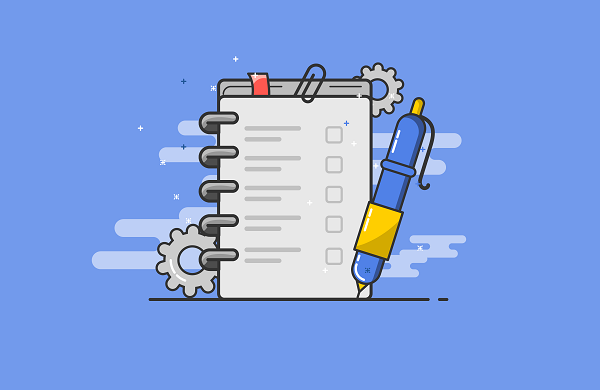
1. What’s the goal of the questionnaire?
This may be the most important aspect of the questionnaire creation process. The goal of your questionnaire will determine both the type and questions to ask your respondents.
As mentioned earlier, if you’re in the beginning stages and are still trying to form a hypothesis, it’s an exploratory questionnaire with open-ended questions. If you’re trying to prove or disprove an already formulated solution or hypothesis then a standardized questionnaire with closed-ended questions would be used.
A clear goal also makes it easier to determine if a specific question is necessary or not. For example, if you’re doing initial product Buy research papers for a dog toy, a question about the kinds of toys they’ve purchased in the past may be useful. When you have an initial prototype dog toy and want to gauge market response, that question wouldn’t be as useful to you.
2. Who is the target group?
Whether or not it’s obvious, every market has multiple groups within it. Let’s take an average SaaS company for example. It usually has pricing tiers that are mapped to different personas. The customers on each subscription plan have different wants and needs.
The questionnaire you create and send out should reflect that. If you have the resources, create more than one so you can cater to the specific needs of different groups in your customer base.
In a situation where you’ve not seen different customer groups, it may be worth it for you to identify and segment your customers. Not only will your messaging become more effective, any time you send out a questionnaire or a survey, but it’ll also be more targeted and get a higher response rate. On average, you can expect only 12.5% of an external audience (nonemployees) to respond to your survey.
Developing an ideal questionnaire is greatly dependent on identifying the appropriate questions to ask. This process includes not only choosing questions that closely match your research objectives but also crafting them in a way that garners straightforward and neutral answers.
Employing a tactful questioning technique can reveal more profound insights, thereby enhancing the efficacy of your data-gathering efforts. To gain a broader perspective on establishing connections via skillful questioning, it’s recommended to explore the nuances of formulating highly influential questions.
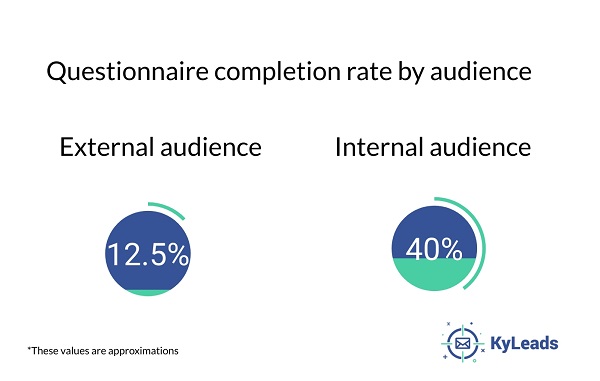
3. How will you reach the target group?
This is often overlooked until the last minute but it’s an important consideration. If you have an email list full of past and present customers then this may not be an issue for you.
What about when you’re trying to enter a new market with a new type of product and don’t have customers there? How will you be able to reach them? Can you even reach them online?
This can have major implications on the design of your questionnaire. For example, if it’s a paper-based questionnaire, the design will necessarily be different and the questions won’t be as dynamic. If you’re using ads to get people to take your questionnaire, you may need to provide an incentive and make it shorter.
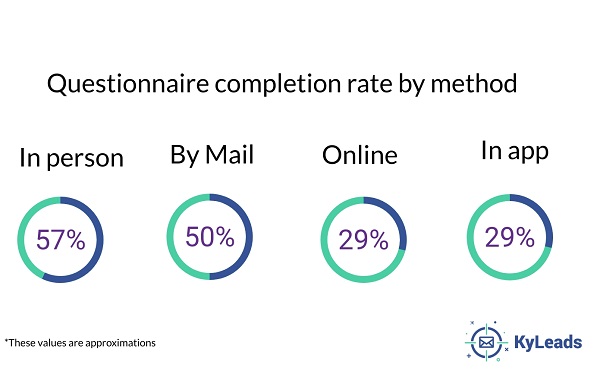
4. Do you have a clear question progression?
The way your questions are ordered sets the tone for the entire questionnaire. You don’t want to start with a deep philosophical question that challenges the meaning of life. That’s too heavy. Almost everyone will bounce.
Instead, you want to start with simple questions that almost anyone can answer without too much thought. These are questions like age, sex, and geography – demographic information. These answers can also be used to further segment your respondents.
After discussing the foundational elements of questionnaires, it’s essential to consider modern advancements. ChatGPT Integration represents a significant leap in this direction.
With the rise of AI and chatbots, integrating tools like ChatGPT into your questionnaire process can greatly enhance user engagement. By utilizing ChatGPT, businesses can provide real-time assistance to respondents, clarifying questions, offering instant feedback, and ensuring a more interactive and smoother experience.
Additionally, exploring ChatGPT alternatives can provide diverse functionalities and features to better suit specific business needs. Diverse AI solutions ensure that each questionnaire feels tailored and responsive, significantly boosting respondent satisfaction. Among these alternatives, some platforms specialize in nuanced language processing, while others excel at handling large volumes of data efficiently.
This flexibility allows for customization at a level that best suits the unique demands of each project, making the deployment of AI in questionnaires not just innovative but also highly adaptable to varying requirements.
As part of a comprehensive AI strategy, these tools can be aligned with broader business goals, ensuring that AI-driven initiatives are both effective and scalable.
Such integrations not only streamline the response process but also pave the way for richer data collection and insights.
After you’ve built up some momentum, move into the core questions you want an answer to. The questions you ask here will depend on your goals but it should relate to your products and services. These questions help you flesh out your product development initiatives as well as create better and more focused marketing messages.
Finally, tie up any loose ends with your final questions. A common but subpar question is “is there anything else you think we should know?” try to avoid this one. Instead, ask things like how they found you, their experience with buying another similar product, how they’d describe a specific problem, etc.
5. What kind of questions will you use?
Do you want well thought out answers that give you deep insights into the inner workings of the respondent’s mind? Or, do you want a narrow but easily analyzed response? The type of questions you use will determine the type of data you get.
As a rule of thumb, open-ended questions are often used earlier in the research process. Closed-ended questions tend to be used to prove or disprove hypothesis or solutions. Of course, you can use both of them but be sure to pay close attention to question progression so respondents aren’t put off or confused.
6. Length of questionnaire
There are no hard and fast rules about how long your questionnaire should be. Some of them are hundreds of questions while others are less than five questions. The more questions, the lower your completion rate.
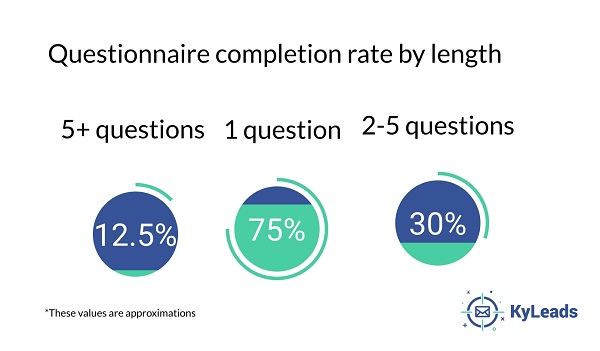
On average, it takes 5 minutes to answer 10 questions. Depending on whether the answers are open-ended or close-ended, the time could be considerably more.
Your customers are busy and most of them won’t sit through a long questionnaire without some form of incentive or compensation. If you’re able to provide that then fine but most customer surveys shouldn’t require it.
Instead, be considerate of the time of others. Keep your questionnaires less than 15 questions and ideally under 10 questions. It makes it easier for respondents to complete the survey and easier for you and your team to analyze the information.
Navigating the complexities of data collection in the digital realm requires a keen understanding of legal boundaries, particularly when dealing with sensitive financial information. Engaging a credit report lawyer becomes essential when your surveys delve into areas that might influence someone’s credit standing.
These legal advisors are adept at ensuring your methods are in line with stringent standards, such as those outlined by the Fair Credit Reporting Act. Their counsel is vital in crafting data handling procedures that not only respect individual privacy rights but also uphold the integrity of your business operations, thereby mitigating risks associated with credit information mismanagement and privacy infractions.
7. Presentation
Contrary to popular belief, you don’t need a thousand bells and whistles to get people to take your questionnaire. A simple design that emphasizes the questions is more valuable than a flashy one. Of course, you can go flashy if you like. The thing is, most people just don’t care.
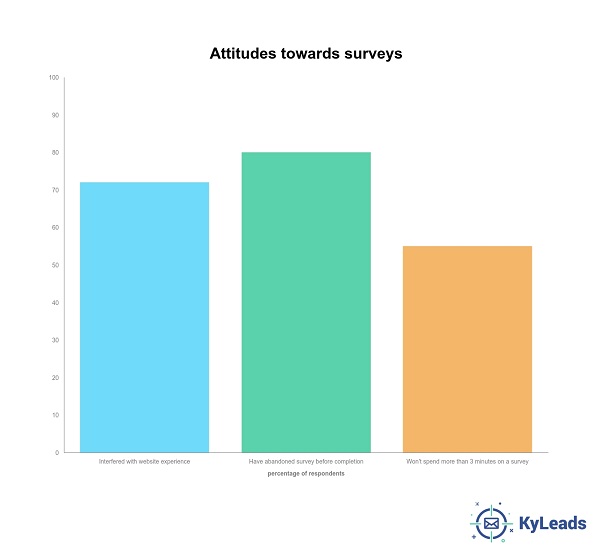
Select a font that’s easy for people to read and make sure the size is large enough to be legible on all devices. Apart from that, keep the number of pages to a minimum. 2 pages is much better than 30 pages when it comes to a questionnaire.
When you’re ready to present your findings, that’s when you can get flashy. You can use one of these presentation websites to create slides that display the insights you’ve gathered.
Featured Training
This guide is long, detailed, and should serve as a constant reference. Instead of constantly coming back to check it, download the PDF version. When you download it, you’ll also get access to our free email training that shows how to use questionnaires, quizzes, and popups to understand, engage, and convert visitors to leads and customers.
8. Choose language carefully
If you ask a question that creates bias or confuses your respondents then you may accidentally contaminate your data. Use clear terms, be concise, and avoid industry jargon.
For example, “We’ve been told we make great eggs, would you agree or disagree?” this question causes bias before the customer can answer. An unbiased question would be “how would you rate our eggs on a scale of 1 – 5?”
Also, avoid combining multiple questions into one. An example of a combination question would be “how did you enjoy your stay and would you recommend us to a friend?” These are two distinct questions bundled into one.
Advantages & disadvantages of questionnaires
It’s important to understand both the pros and cons of questionnaires and put proper safeguards in place before you start using them to make important business decisions.
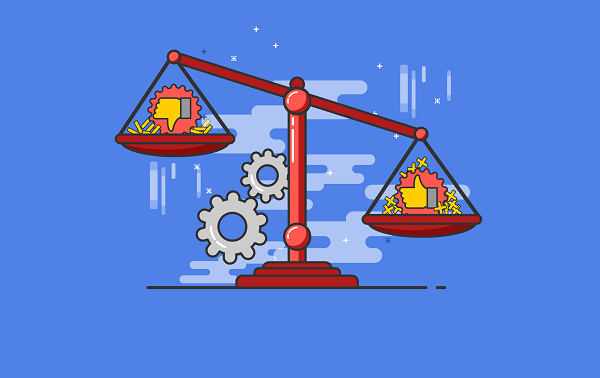
Advantages
Let’s start with a few of the good things.
Inexpensive
Sending out an online questionnaire is one of the cheapest customer research strategies available. Unless you’re offering some type of incentive or are using ads to get in front of respondents, there are few costs associated with it.
Self-administered questionnaires avoid the need for hiring people to administer it, remove the cost of in-person interviews, and have versatile distribution methods.
Results come in quickly & can reach a large audience
Business moves fast so one of the most powerful advantages of a questionnaire is the ability to get it in the hands of a large group of people quickly. You don’t need to start mailing it out and waiting days for it to get to the intended recipient.
Instead, you can send emails to many recipients using bulk email services, post it on your website, or share it on social media and start getting responses you can use almost instantly. Also, there’s no real upper limit to the number of people who can respond to the questionnaire.
Easy to analyze the results
The majority of questionnaires are quantitative in nature which allows for quick analysis of the answers. This is even more important when you have a larger pool of respondents.
With a survey tool like KyLeads, you can easily spot trends and derive insights from your questionnaire with our easy to use & understand reporting features.
Respondents can remain anonymous
If respondents are unable to remain anonymous, they may not answer some of the questions truthfully. As long as you’ve done proper targeting and they’re not answering for an incentive, it’s ideal to leave the respondents anonymous. They’ll be more comfortable and answer honestly and thoroughly.
Can cover all aspects of a topic
This is an overlooked aspect of questionnaires. With them, it’s possible to ask 100 questions. Of course, we don’t advise this because almost no one will finish an online questionnaire of that length.
With that being said, you can ask as many questions and solicit as much detail as you want. Play around with the number of questions you ask but try not to overdo it.
For instance, a real estate agent might use a questionnaire to understand the specific needs and preferences of potential homebuyers. By asking targeted questions about desired locations, types of homes, budget constraints, and must-have features, the agent can gather valuable insights.
This information not only helps in tailoring property suggestions but also in refining marketing strategies to attract the right clientele. Moreover, such questionnaires can be a great tool for building a database of client preferences, aiding in future property recommendations and personalized service offerings.
Disadvantages
There are a few disadvantages to questionnaires which you should be aware of.
Unanswered questions
Sometimes, people will just skip answers or drop off halfway. Since the questions are online and no one is there to prompt the respondent, this happens fairly often.
There is any number of reasons for this like unclear or confusing questions, irrelevant questions, incomplete answer options, etc. Making the answer required can help with this but it also increases the chances of someone abandoning the questionnaire altogether.
Questionnaire fatigue
Fatigue with your survey as well as the other surveys being sent out by other companies. More and more companies are using surveys and customers can’t answer all of them. This results in a lower overall response rate to surveys or questionnaires as a whole.
Conversely, someone may start your survey but drop off because there are too many questions or the questions seem to be irrelevant. You can’t get rid of the fatigue 100% but you can reduce it by creating shorter questionnaires and making your questions easy to answer.
Little personalization
Everyone who takes the questionnaire gets, for the most part, the same series of questions presented in the same way. Now, technology is making this better with features like logic branching and answer piping so the experience can be personalized a bit more.
In the end, it’s still limited because there’s a predetermined series of questions and the questionnaire can’t react to open ended statements.
Improper interpretation of questions
This is why it’s so important to choose your question language so carefully. It’s easy to misinterpret a written question and give a wrong answer or skip the question entirely. Another thing to consider is that certain words have multiple meanings and, without context, a different meaning may be applied.
Prevent this by using simple direct language in your questions and avoiding jargon.
Difficult to analyze certain types of questions
Multiple choice questions and dichotomous questions are simple to analyze. Open ended questions can’t be analyzed so easily.
They’ll require a human touch to ensure you’ve understood what the person is trying to tell you. This isn’t a bad thing but it can get tedious when there are a lot of answers to sift through.
Examples of questionnaires
There are countless types of questionnaires and surveys you can use to get deep insights about your customers and business. In this section, you’ll learn 6 common types that’ll help you improve your business immediately.

Brand awareness
This questionnaire example is ideal when you’re actively focusing on building awareness and doing demand generation. It helps you gauge whether or not your efforts are yielding fruit.
It’s one thing for people to end up on your website through a search on Google or a random post on social media. It’s another thing for there to be brand recall or positive associations about your business.
It’s impossible to stay on the sidelines when social media is taking over the world.
That’s why it makes sense to consider this option: include the latest social media trends in your questionnaire and gain powerful insights into how these trends are influencing consumer wants and shaping their expectations and associations with your business.
In addition to evaluating traditional website traffic and search engine rankings, this is also a great technique for gleaning relevant information.
The brand awareness questionnaire will give you a better understanding of whether people looking for solutions you provide think of your brand, the kind of associations your name creates, and if you’re considered a leader in your field.
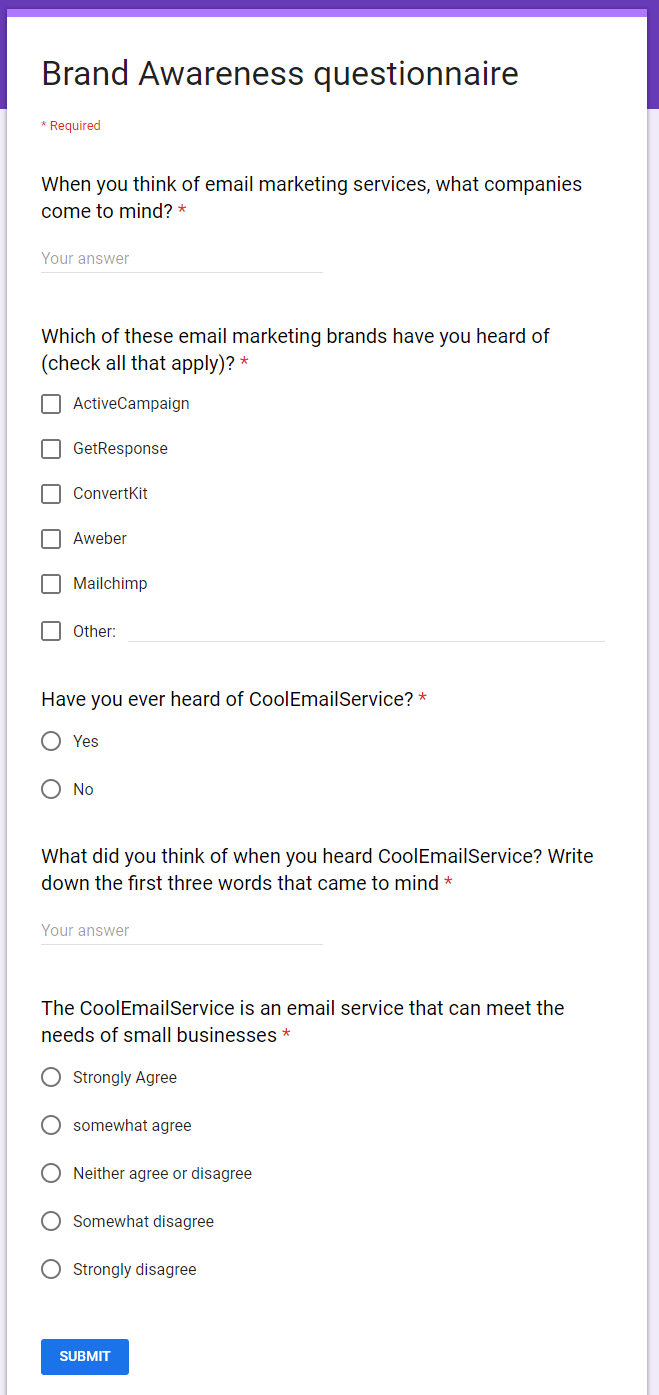
NPS
The NPS questionnaire has become popular over the last few years and it helps you measure customer loyalty and satisfaction.
It’s important to note that in its original form, it’s measuring loyalty and satisfaction that pertains to your entire business as opposed to specific products.
It uses a scale to measure customer loyalty. You calculate the score by subtracting the percentage of detractors from promoters and it’s expressed as an absolute number.
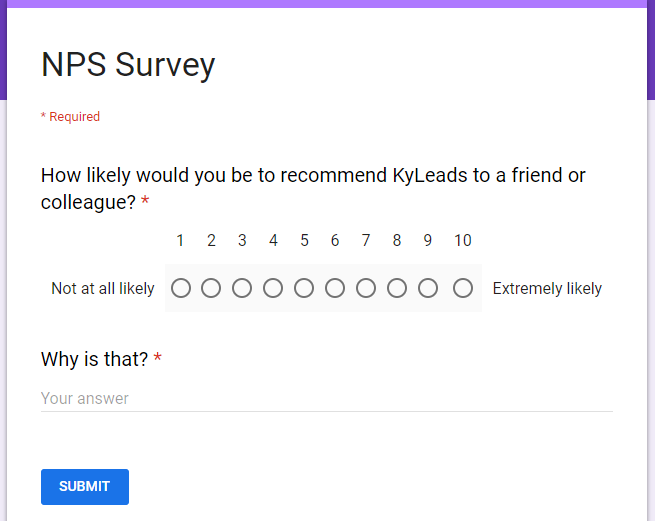
CSAT questionnaire
The customer satisfaction (CSAT) questionnaire example we’re sharing is just one of many. CSATs are incredibly varied. Even the NPS questionnaire is a type of CSAT. In general, it’s used to understand how satisfied a customer is with specific products and services or your business as a whole.
Use the basic outline below then tweak the questions to apply to your business or specific product lines. For example, if you were a shoe company, you could ask how often they wear shoes purchased from you.
If you were a hair extensions company, you could ask how satisfied they were with the product or the shopping experience as a whole.
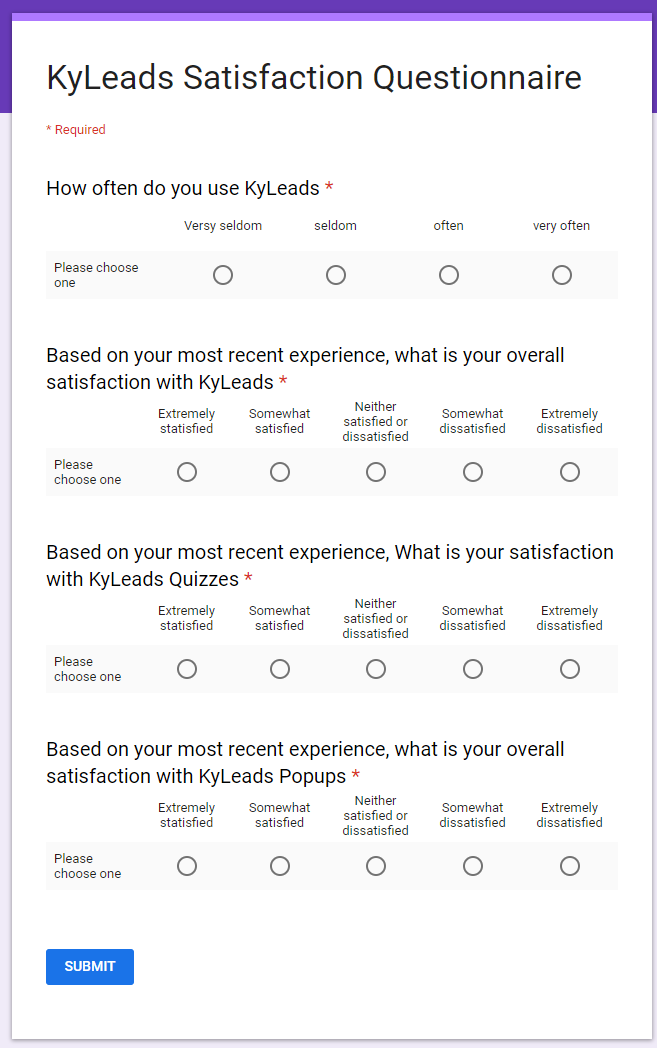
Demographic questionnaire
Demographic questionnaires are often used to identify and segment the groups you have in your audience. This type of questionnaire is ideal if you’re entering a new market and want to start building up a profile of the people who will be your customers.
At the same time, you may want to use this to understand your current customer base so you can create better messaging or product pricing.
Oftentimes, the demographic questions are a small part of larger questionnaires used to understand who’s giving what kind of answer.
For example, if you serve a customer group that varies in age and income, you’d like to know what kind of customers are giving answers so you can make decisions properly.
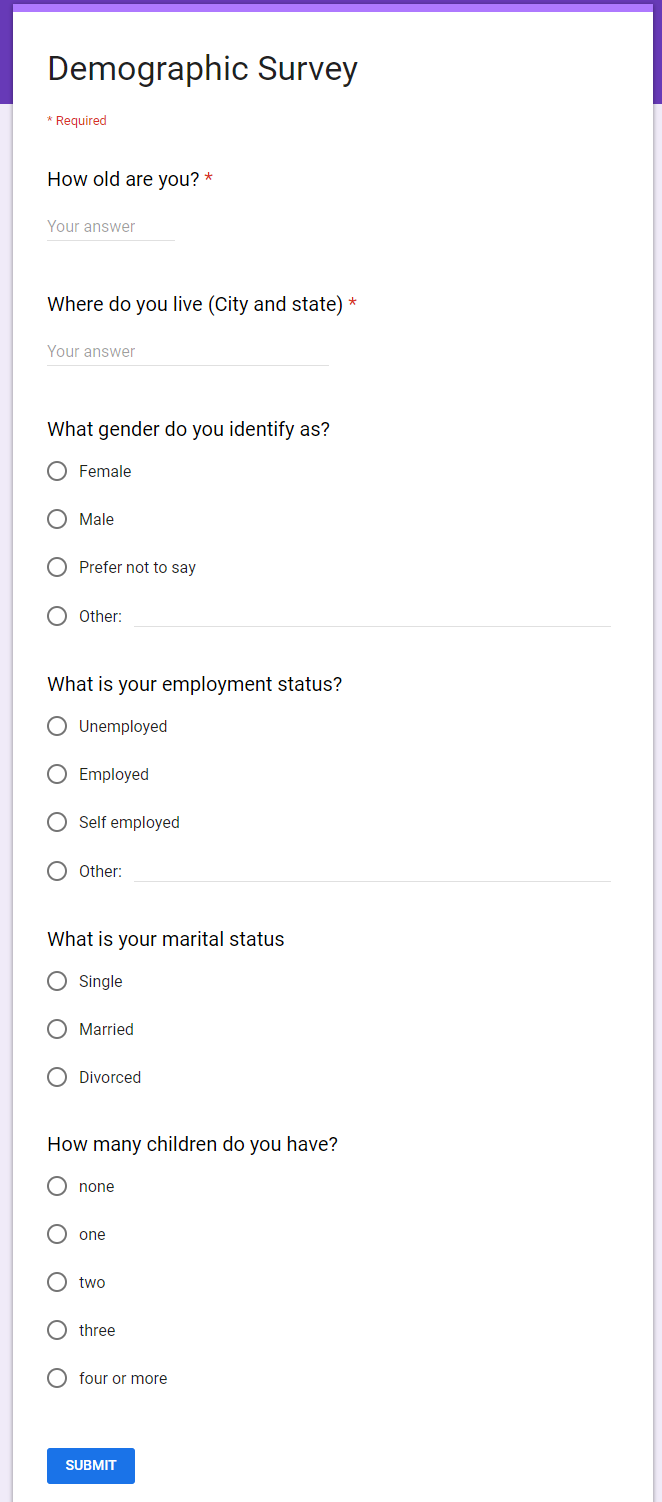
Psychographic questionnaire
Psychographic segmentation has a firm place in modern business because everyone has demographic data (or can get it).
Demographic segmentation pales in comparison to knowing why a group of people do what they do.
Look at it this way, demographic data helps you understand the characteristics and buying power of your customers.
Psychographics helps you understand the why behind their actions and their attitudes behind certain stances. It can be a goldmine if gathered and used properly.
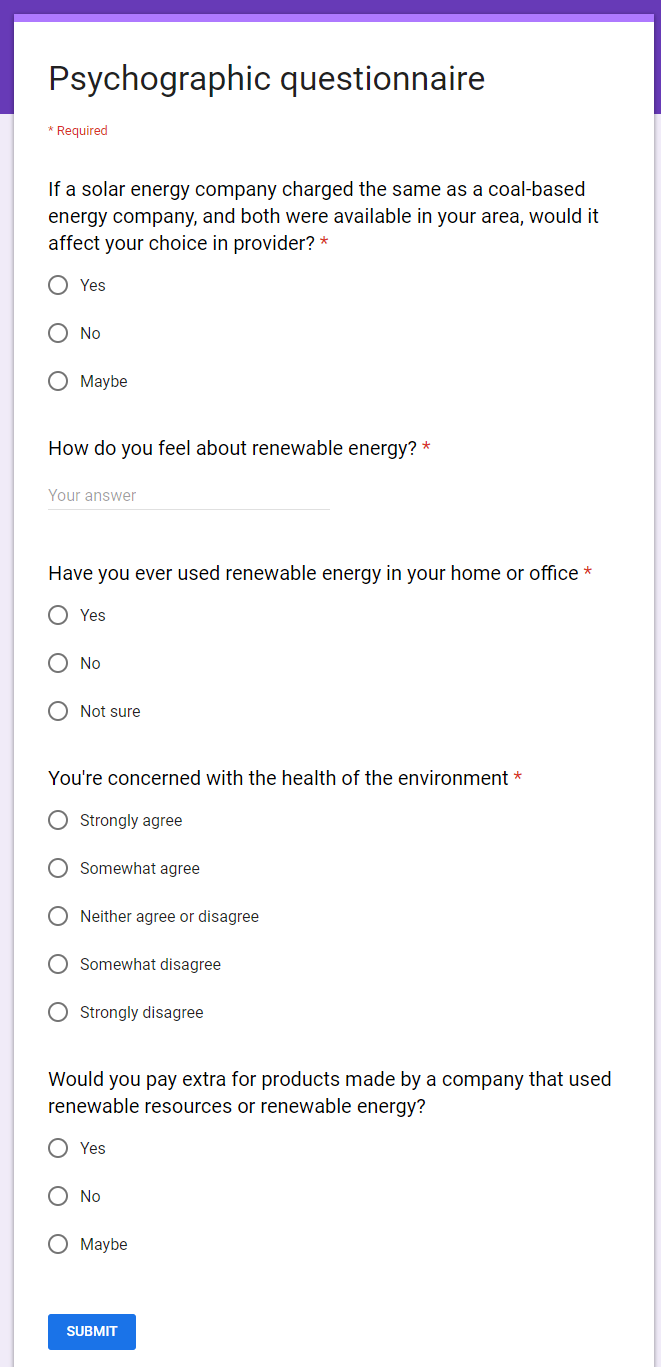
Post-event questionnaire
Ah, events. If you’re like most of us mere mortals then there’s a love-hate relationship with them. On the one hand, if they go off well then it can power your business to the next level.
On the other hand, everything that can go wrong probably will. As the organizer of the event or someone who had a key role, it may seem like you know exactly what went right and what went wrong.
If you don’t get feedback from as many people as possible then those are just assumptions which may or may not be correct.
Use post-event surveys to talk to as many people as humanly possible to get a clear picture of how you can improve.
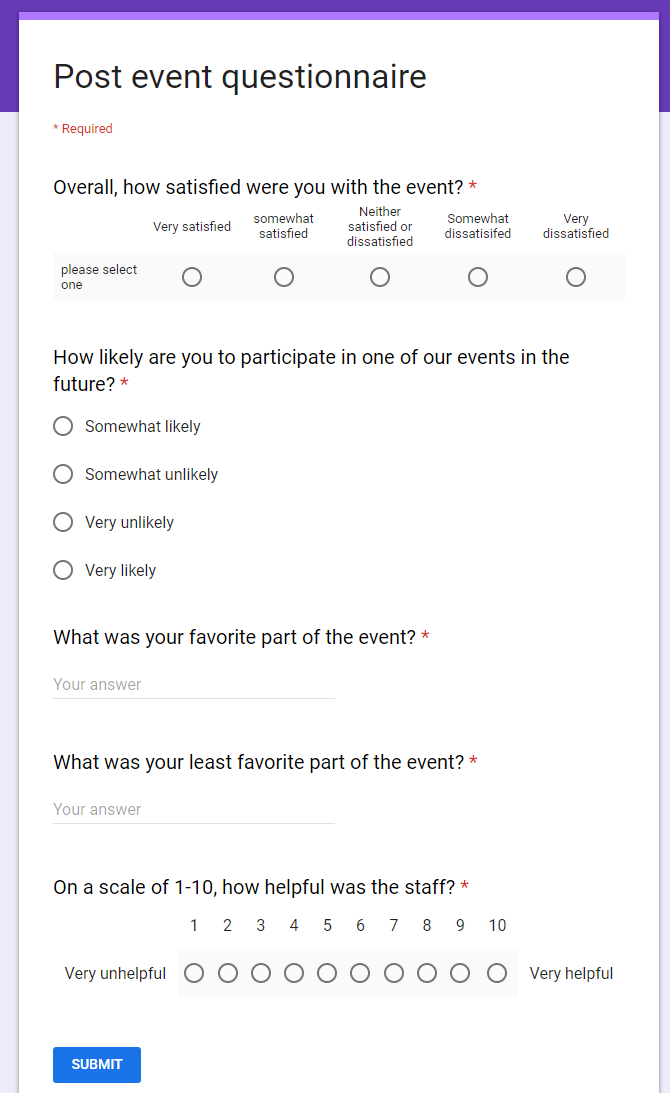
Conclusion
This guide has covered a lot of ground so don’t expect to cram everything in one sitting.
Questionnaires are the backbone of surveys. Without them, there’s nothing to analyze. Before you dive in and start designing your questionnaire to collect all that juicy customer data, there are a number of things to do.
Decide on the type of questionnaire and your goals, focus on the right questions, figure out who the target group is, and so much more. Be sure to revisit this guide whenever you’re in doubt.